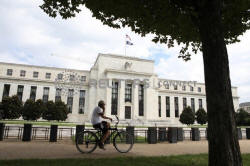Fed meeting expected to leave U.S. bond-stock
relationship out of whack
 Send a link to a friend
Send a link to a friend
 [July 27, 2020] By
Gertrude Chavez-Dreyfuss and Karen Pierog [July 27, 2020] By
Gertrude Chavez-Dreyfuss and Karen Pierog
NEW YORK (Reuters) - The Federal Reserve's
whatever-it-takes approach to stave off economic calamity has kept
interest rates near zero and helped drive U.S. stocks back to
pre-pandemic record levels, while weakening the usual dynamic between
safe-haven U.S. Treasuries and riskier equities.
Stocks and bonds' moving in parallel is one of the distortions Fed
policy makers may ponder when they meet next week, although they are
expected to let the emergency measures already implemented in the wake
of the coronavirus outbreak work through the financial system.
The recent rise in Treasury prices, which typically climb when investors
seek safe harbors during uncertain times, appears at odds with the
exuberance seen on Wall Street, where the S&P 500 last week came within
3.5% of its February all-time high, set before it was clear the spread
of COVID-19 would wreak havoc around the world.

The S&P 500 500 <SPX> and U.S. 10-year Treasury notes <US10YT=RR>
typically move in opposite directions, such that when equities rise
during periods of confidence and risk-taking, bond prices fall, pushing
yields, which move inversely to prices, higher.
Analysts have said the traditionally negative correlation between stocks
and bonds reflects the extent to which bonds will effectively hedge
against a stocks sell-off, such as what happened during the global
financial crisis in 2008.
That relationship has broken down at times during the pandemic. For
instance, since mid-June, U.S. benchmark 10-year yields have fallen more
than 20 basis points, while the S&P 500 has gained roughly 5%.
(GRAPHIC: Treasuries vs stocks:
https://fingfx.thomsonreuters.com/
gfx/ce/rlgpdnlxjpo/Pasted%20image%201595601040892.png)
Gennadiy Goldberg, senior rates strategist at TD Securities in New York,
said the irregularity between the two markets can be explained by the
stimulus measures undertaken by Congress and quantitative easing on the
part of the Federal Reserve.
"The Fed and the government have pledged ongoing support for the
economy, which has pushed risky assets higher," he said. "At the same
time, the Fed wants to keep rates low in order to keep stimulus in place
and to prevent a tightening in financial conditions."
The Fed slashed the fed funds rates to near zero in March and launched
lending and unprecedented debt purchasing programs to boost liquidity
and stabilize financial markets.
[to top of second column] |

A cyclist passes the Federal Reserve building in Washington, DC,
U.S., August 22, 2018. REUTERS/Chris Wattie

"The fact that the Fed has been able to purchase so many bonds and also kind of
commit to keeping rates so low is obviously going to be a positive for stocks,
but meanwhile remove volatility from the rates market," said Ben Jeffery, rates
strategist at BMO Capital Markets in New York.
The Fed's policy-setting Federal Open Market Committee meets Tuesday and
Wednesday, with no major announcements expected. But it may lay the groundwork
for more action in September or in the fourth quarter, analysts said.
With U.S. central bank officials resisting negative interest rates, Fed
officials have talked about yield curve control as a way to target rates at
specific maturities, which should keep borrowing costs ultra-low to spur
spending and bolster the economy.
The yield curve refers to the line created by plotting the rates of different
maturities. A steepening curve, when longer-dated yields rise faster than
shorter-dated ones, generally signals a bright economic outlook.
Under yield curve control, the Fed would cap yields at a specific point on the
curve, by buying 2- or 3-year maturities, for example, to reinforce guidance
that rates are not going up anytime soon.
"We think in September (the Fed) might come out with a little bit more
discussion on the impact of potential additional forward guidance measures of
which yield curve control is one of those," said Tony Rodriguez, head of fixed
income strategy at Nuveen.
Fed policymakers are likely close to a policy framework about future measures.

"In March, the Federal Reserve was buying $75 billion in Treasuries and that was
to help stabilize the economy," said Marc Chandler, chief market strategist at
Bannockburn Global Forex in New York. "But now they may consider measures to
help stimulate the economy and that would be the new quantitative easing."
That should compress U.S. bond yields even more and boost stocks further,
unraveling once again their supposedly time-tested correlation, analysts said.
(Reporting by Karen Pierog and Gertrude Chavez-Dreyfuss; Editing by Alden
Bentley and Leslie Adler)
[© 2020 Thomson Reuters. All rights
reserved.] Copyright 2020 Reuters. All rights reserved. This material may not be published,
broadcast, rewritten or redistributed.
Thompson Reuters is solely responsible for this content. |